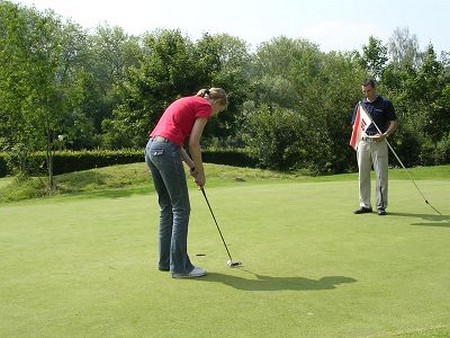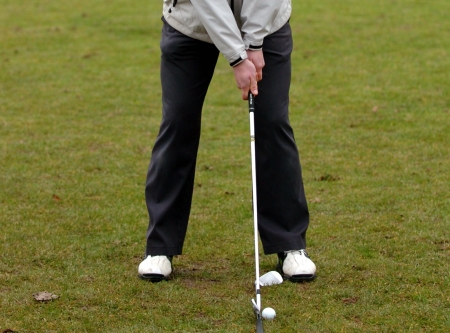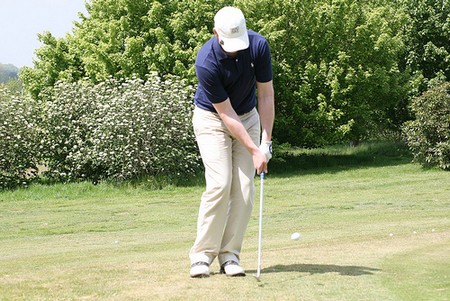Best Way to Play Short Chip-and-Run Shot in Golf
The short chip-and-run shot is, like the putting stroke, a one-lever movement. If played correctly, it gives great accuracy. The two-lever movement (arms and wrists) is used when greater height and length are required.
The choice of club
The club you need to make this shot can vary from a No. 4 iron to a sand iron. The correct choice will depend on the following factors.
- The lie of the ball. Is it a good lie (sitting neatly on top of the grass), is it lying on hard, bare ground, or is it nestling in the grass of the semi-rough?
- The distance to the edge of the green. Always allow for a safety margin, so that a shot struck with less than 100% will still carry the intervening ground and land on the putting surface.
- The distance from the landing point to the flag, and the condition and slope of the green. The ball is about 3 ft (1 m) from the edge of the green, which slopes away from you and is medium-paced. The flag is 33 ft (10 m) from the edge. The ball is lying well, but there is some longer grass between it and the green, preventing you from using the safest club, the putter.
You want the ball to clear the uncut grass on a low trajectory to land about 6 ft (2 m) into the green. In other words, it must fly 9 ft (3 m) before bouncing a couple of times and rolling the remaining 27ft (8 m) to the flag. As the flag is down the slope, you should try to get the ball to stop slightly past the hole, as an uphill putt is easier.
As far as the movement is concerned, the normal chip-and-run shot reminds us of the putting stroke, the only difference being that the ball leaves the ground because the irons are built differently than the putter. On the club face there are a number of grooves, two vertical and eight to ten horizontal. The vertical grooves help you to aim the club, while the horizontal ones create back-spin and control.
The angle of the iron club’s shaft to its head is flatter, so you must stand a little further away from the ball than you would if you were using the putter. For shots of this type, hold the club further down the shaft with your normal grip (for instance, the Vardon grip), because the grip on the iron club is round, not flattened like the putter.
The No. 7 iron has approximately a 35° loft, so to strike the ball correctly hit it at its base and just before the club head has reached its lowest point (just before making contact with the grass). The same amount of movement with a No. 4 iron would send the ball on a lower trajectory and roll it past the flag; with a No. 9 iron or a wedge, the ball would have increased height but would pull up and stop before getting close to the flag.
This means that you have to create a picture of the ball’s flight and roll in your mind’s eye before you choose your club.
The chip-and-run grip
Holding the club correctly and aiming the club head towards the intermediate target are probably the least exciting parts of golf, but they are absolutely the most important. If you don’t hold the club correctly, aim it correctly and stand correctly to the ball, your chances of a successful shot are very slight indeed.
Stance
Place the club head on the ground, flat on its sole and with the club face aimed at the intermediate target. Be sure that the shaft is straight (your hands neither in front of nor behind the ball). Then take your stance in the following way.
- With your feet the same distance apart as for the putt, keep your knees flexed, the toes of both feet swivelled very slightly to your left and your weight mainly on the left foot. Move your arms, hands and shaft so that they are in front of the ball and ensure that you have a straight line from your left shoulder through your left arm and shaft to the club head. Check to see that the club face still points towards the intermediate target.
- Now open the stance a little by moving the left foot back 3 – 4 in (8 – 10 cm). This turns the lower part of your body slightly towards the target; this, together with the flexed knees and the weight on the left foot, helps to ensure a downward blow that strikes the ball first and then the grass, creating the desired trajectory.
Posture
With knees flexed and pointing a little towards the target, weight on the left foot and with a shortened grip, the hands should be in front of the left thigh and just above the knee. Those parts of the body nearest the target (left arm, hip and shoulder and the left side of the face) should be in front of the ball, which is centred between the feet.
The beginner will find this position tiring, so don’t practise it for too long. Every few minutes, stand up straight, stretch and rest a little. When you have adopted the correct posture, the left arm and the club shaft will form one side of a triangle. The other side is formed by the right forearm, and the third by a line between the shoulders. This triangle should remain constant throughout the movement.
Movement
The movement is similar to that of putting, with the arms only creating the necessary amount of back-and-forward motion, and no wrist movement for the shorter chips. The distance the club head travels dictates the length the ball will fly and is the same on the backswing and on the follow through. This is sometimes difficult to see, as the club head on the follow through should finish closer to the ground than it was at the top of the backswing. This is due to the weight being mainly on the left foot.
Practise creating the pendulum movement with natural acceleration down to the ball, holding the finish position with the triangle intact and the club face pointing towards the target, ensuring that the weight is constant on the left foot and that the movement comes only from the arms.
With the experience gained from practising the chip-and-run, you will understand how the choice of club, the address position and backswing will affect the length and height of the shot, and the amount of roll after landing.
Categories
Advertisements
Recent Articles
 How to Understand Bed Sizes – A Small Guide
How to Understand Bed Sizes – A Small Guide How to Select Some Must Have Kitchen Accessories
How to Select Some Must Have Kitchen Accessories Best Way to Change a Car Tire
Best Way to Change a Car Tire Best Way to Write an Affirmation
Best Way to Write an Affirmation Best Way to Take Charge of Your Financial Life
Best Way to Take Charge of Your Financial Life Best Way to Survive a Party When You Don’t Know Anyone
Best Way to Survive a Party When You Don’t Know Anyone Best Way to Stop Self Sabotaging Yourself
Best Way to Stop Self Sabotaging Yourself Best Way to Start Journal Writing
Best Way to Start Journal Writing Best Way to Speak with a Powerful Voice
Best Way to Speak with a Powerful Voice Best Way to Simplify Your Life
Best Way to Simplify Your Life Best Way to Respond to a Put-Down
Best Way to Respond to a Put-Down Best Way to Reduce Acne Breakouts
Best Way to Reduce Acne Breakouts Best Way to Recover from Dining Disasters
Best Way to Recover from Dining Disasters Best Way to Quit Your Job Gracefully
Best Way to Quit Your Job Gracefully Best Way to Make Your Own Website
Best Way to Make Your Own Website




Leave a Reply